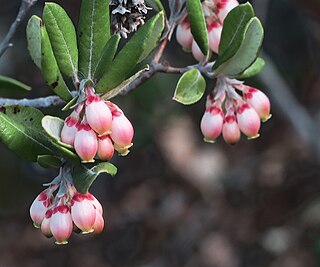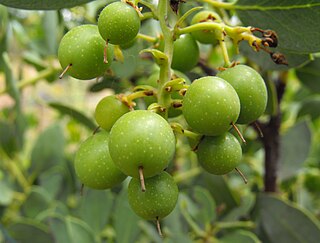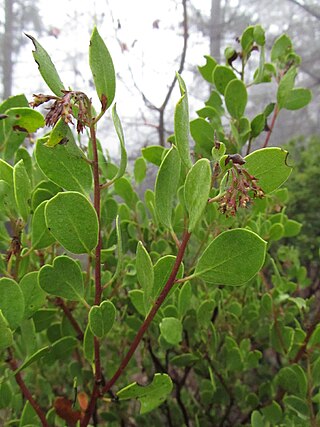
Arctostaphylos is a genus of plants comprising the manzanitas and bearberries. There are about 60 species of Arctostaphylos, ranging from ground-hugging arctic, coastal, and mountain shrub to small trees up to 6 m (20 ft) tall. Most are evergreen, with small oval leaves 1–7 cm (0.4–3 in) long, arranged spirally on the stems. The flowers are bell-shaped, white or pale pink, and borne in small clusters of 2–20 together; flowering is in the spring. The fruit are small berries, ripening in the summer or autumn. The berries of some species are edible.

Ornithostaphylos is a monotypic plant genus which contains the single species Ornithostaphylos oppositifolia, commonly known as the Baja California birdbush or Baja California manzanita. A large, evergreen shrub in the heather family, this species is near-endemic to northwestern Baja California, with a small population just north of the border in San Ysidro, California. It produces a much-branched inflorescence of white, urn-shaped flowers, and has leathery leaves that appear opposite or in whorls. These characteristics separate it from its close relatives in the region, which include manzanitas (Arctostaphylos), summer holly (Comarostaphylis) and mission manzanita (Xylococcus).

Arctostaphylos glandulosa, with the common name Eastwood's manzanita, is a species of manzanita.

Arctostaphylos pallida, commonly known as pallid manzanita, Oakland Hills manzanita, and Alameda manzanita, is an upright manzanita shrub from the Ericaceae, or heath family. It is endemic to the eastern San Francisco Bay Area of Northern California.

Arctostaphylos glauca is a species of manzanita known by the common name bigberry manzanita. It is native to California and Baja California, where it grows in the chaparral and woodland of coastal and inland hills.
Arctostaphylos glandulosa subsp. gabrielensis, known by the common name San Gabriel manzanita, is a subspecies of manzanita. It is endemic to one small area in the San Gabriel Mountains of Los Angeles County, California.

Arctostaphylos mewukka is a species of manzanita known by the common name Indian manzanita.

Arctostaphylos montaraensis, known by the common name Montara manzanita, is a species of manzanita in the family Ericaceae.

Arctostaphylos obispoensis is a species of manzanita, known by the common names bishop manzanita and serpentine manzanita, endemic to California.

Xylococcus is a monotypic genus of flowering plants in the heather family which contains the single species Xylococcus bicolor, commonly known as the mission manzanita. It is a burl-forming, evergreen shrub with leathery leaves and smooth dark reddish bark. From December to February, white to pink urn-shaped flowers adorn the foliage, often attracting hummingbird pollinators. It is native to southern California and the Baja California Peninsula, south to the Sierra de la Giganta. There is growing concern over the future of this plant, referred to as the "queen of the elfin forest, " as it may possibly lose up to 88% of its habitat and its wild seedlings are failing to survive more than a full year.

Arctostaphylos rainbowensis is a species of manzanita known by the common name Rainbow manzanita. It is endemic to California, where it is known only from northern San Diego and southern Riverside Counties in the Peninsular Ranges.
A. glandulosa may refer to:

Arctostaphylos gabilanensis is a rare species of manzanita known by the common name Gabilan manzanita.

Arctostaphylos ohloneana is a rare species of manzanita known by the common name Ohlone manzanita in the Santa Cruz Mountains in California. It is endemic to northwest Santa Cruz County, where it is known only from four populations on Ben Lomond Mountain, just south of Big Basin Redwoods State Park.

Arctostaphylos hooveri, the Santa Lucia manzanita, is a plant species endemic to the Santa Lucia Mountains in Monterey County, California. It grows in woodlands and in chaparral scrub-land at elevations of 900–1200 m.

Arctostaphylos glandulosa subsp. crassifolia is a rare perennial shrub, a subspecies of manzanita within the heather family commonly known as the Del Mar manzanita. It is narrowly endemic to the sandstone coastal terraces of San Diego County and northwestern Baja California. It is a burl-forming evergreen shrub typically found growing in a rambling habit on poor soils and hardpan. From December to February, white to pink urn-shaped flowers decorate its foliage, giving way to small fruits. It is listed as endangered and is threatened by land development, invasive species and modifications to the natural fire regime.
The Cerro Bola is a coastal metavolcanic mountain formation in northwestern Baja California. The Cerro Bola, along with the nearby mountain Cerro Gordo form the highest elevation areas of Tijuana Municipality. Because of its prominence, the transmitters for television station XHDTV and radio station XHPRS-FM are located on the summit of Cerro Bola, which reaches an elevation of 1,260 m (4,130 ft). It is located approximately 35 km (22 mi) south of the Tecate border crossing, and sits at the southwest end of the Valle de Las Palmas. The mountain range is host to a number of rare and endemic plant species, such as Arctostaphylos bolensis and Ceanothus bolensis.

Arctostaphylos crustacea, commonly known as brittleleaf manzanita, is a species of manzanita found mostly in the fog belt of the Central Coast of California and the San Francisco Bay Area.

Arctostaphylos incognita, the Cerro Italia manzanita or Incognito manzanita, is a species of manzanita narrowly endemic to the vicinity of Cerro Italia in northern Baja California, where it grows in chaparral west of the town of Ejido Carmen Serdan.
















